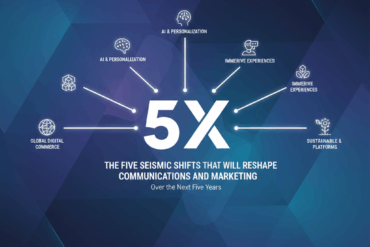Forget cookies and outdated targeting tricks – modern marketers are navigating the ‘mindset era’, where success hinges on deciphering the consumer mindset in real time. How can context, attention and creative help them unlock relevance at scale?
Identity-based ads are losing their grip. Outdated tech and irrelevant targeting are driving users to ad blockers – and away from brands that just don’t get it. Little wonder that 66% of UK and US consumers say most digital ads they’re exposed to aren’t relevant to them.
As signal loss continues to proliferate, and behavioural targeting fails to keep up with fast-changing consumers, advertisers are presented with a once in a generation opportunity to reimagine how they operate and do things better. Successful brands are pivoting towards the role of mindset in the user journey – understanding how consumers feel and what they’re interested in, in the moments that matter.
Get in the mood: context, creative and intelligence
Now, it doesn’t matter where someone’s from, what their age or their gender is, or any other identifying factor. What matters is using real-time, cookie-free signals, to truly understand a user’s changing mindset and the message or product which will resonate most effectively. And that’s why industry experts are coining this new chapter in advertising the ‘mindset era’.
To connect in the mindset era, brands need to pull three key levers: context, attention and creative. These are currently the hottest topics in the industry, and typically treated separately. But to truly understand the consumer mindset, they need to be brought together and analysed as a unified whole. The result is relevant and engaging ads across all digital platforms, throughout the open web.
For instance, GumGum‘s Mindset Graph maps billions of data points, including contextual cues, creative elements and viewer attention metrics, to deliver ads that match the consumer’s current context and mindset – helping advertisers achieve reach and relevance at scale.
But how can marketing’s new holy trinity of context, creative and attention work in harmony together, and what do advertisers need to know, to get the best out of each one?
1. Read the room (aka context is still king)
Understanding the environment around the ad – its emotion, tone, and relevance – means meeting the consumer in a relevant mindset.
AI-powered contextual analysis is so advanced now that it can analyse all of the data signals within digital environments on the open web – including text, image, video and audio – with a human-like understanding of the content users are engaging with, and how to serve suitable, safe and relevant ads. This latest chapter in contextual intelligence is about understanding the content that users are interested in and then using advanced measurement tech to analyse their engagement levels in real time.
“The open web is a goldmine of information relating to brands, their competitors and consumers,” explains Peter Wallace, general manager at GumGum. “Historically, the challenge has been harnessing this data at scale, processing and presenting it. But now brands are using contextual technology to uncover new and exciting insights that help them inform and enrich their entire strategy. The potential is huge.”
Not surprisingly, getting context right drives results: almost 80% of consumers say they’re more likely to take an interest in and act on ads that match the content they’re viewing, according to research from GumGum.
2. Don’t just show up, show off
You’ve got the right context – now seal the deal with bold, relevant creative. Industry research has long told us that creative quality is responsible for 50% of media impact. And creative that responds to mindset, wins hearts, minds and market share.
Advertisers now have the potential to use high-impact formats like desktop and mobile skins which provide them with the right storytelling vehicle to deliver impactful and engaging creative to consumers at the most relevant moments. And leading brands are using data to break down exactly which portion of the creative is adding to the user experience and capturing more attention, so they can optimize and improve in real time.
Take, for example, UK National Lottery operator Allwyn’s Summer Olympics campaign to increase brand awareness and consideration. Contextual analysis showed that, for this campaign, Allwyn thrived in Food and Drink, Television and Events & Attractions categories. That insight combined with online video and high impact display creative helped drive a 13 point increase in brand awareness and a seven-point uplift in purchase intent.
3. Attention: earn, don’t assume
Receptiveness to advertising isn’t earned through relevant and high-impact content alone. To truly connect, advertisers need a deep-dive into user behaviour and content context. That’s why the full power of the mindset approach comes to life when combined with attention measurement.
“If contextual targeting helps an advertiser to understand the content a user is interested in and how the creative can tap into their active mindset, attention technology allows advertisers to measure these activations in real-time and optimize accordingly to drive the best brand and business outcomes,” says Wallace.
One such example is the BBC’s campaign to generate excitement around Christmas special episodes of its iconic show, Doctor Who. Contextual targeting pinpointed categories such as entertainment, TV, movies, sci-fi and lifestyle. High-impact desktop and mobile skin formats featured a countdown timer to build excitement around the launch of the shows and act as a prompt to tune in.
But attention metrics widened the breadth and the potential of the campaign even more: measuring the attention time on both ad formats revealed new, topical contextual categories such as rugby and boxing delivered great results. Optimizing delivery in this direction helped beat Dr Who viewing figures, with total viewing 40% higher than previous series.
As Wallace sums up: “With traditional data signals waning and audiences fragmenting, brands that combine contextual precision, creative resonance and real attention data won’t just keep up – they’ll lead. This isn’t about chasing impressions: it’s about making real ones.”
To find out more about how you could magnify your relevant reach, visit GumGum.
Feature image credit: GumGum.


